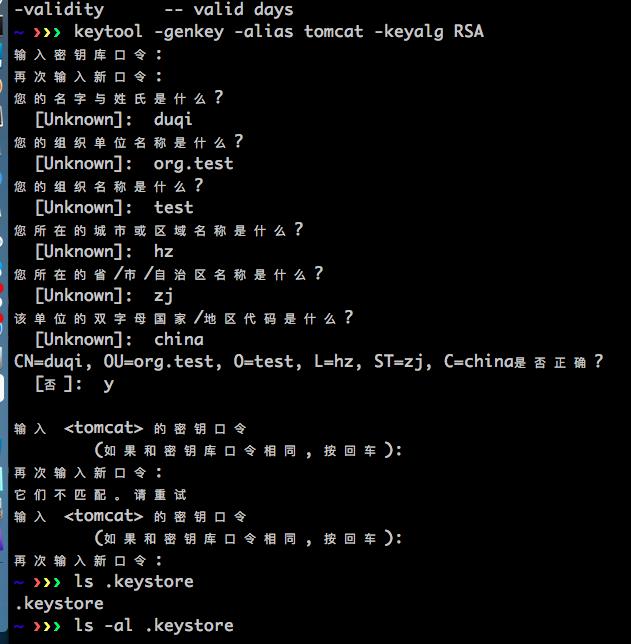如今,企业级应用程序的常见场景是同时支持HTTP和HTTPS两种协议,这篇文章考虑如何让Spring Boot应用程序同时支持HTTP和HTTPS两种协议。
准备
为了使用HTTPS连接器,需要生成一份Certificate keystore,用于加密和机密浏览器的SSL沟通。
如果你使用Unix或者Mac OS,可以通过下列命令:keytool -genkey -alias tomcat -keyalg RSA,在生成过程中可能需要你填入一些自己的信息,例如我的机器上反馈如下:

可以看出,执行完上述命令后在home目录下多了一个新的.keystore文件。
How Do
- 首先在resources目录下新建一个配置文件tomcat.https.properties,用于存放HTTPS的配置信息;
custom.tomcat.https.port=8443
custom.tomcat.https.secure=true
custom.tomcat.https.scheme=https
custom.tomcat.https.ssl=true
custom.tomcat.https.keystore=${user.home}/.keystore
custom.tomcat.https.keystore-password=changeit- 然后在WebConfiguration类中创建一个静态类TomcatSslConnectorProperties;
@ConfigurationProperties(prefix = "custom.tomcat.https")
public static class TomcatSslConnectorProperties {
private Integer port;
private Boolean ssl = true;
private Boolean secure = true;
private String scheme = "https";
private File keystore;
private String keystorePassword;
//这里为了节省空间,省略了getters和setters,读者在实践的时候要加上
public void configureConnector(Connector connector) {
if (port != null) {
connector.setPort(port);
}
if (secure != null) {
connector.setSecure(secure);
}
if (scheme != null) {
connector.setScheme(scheme);
}
if (ssl != null) {
connector.setProperty("SSLEnabled", ssl.toString());
}
if (keystore != null && keystore.exists()) {
connector.setProperty("keystoreFile", keystore.getAbsolutePath());
connector.setProperty("keystorePassword", keystorePassword);
}
}
}- 通过注解加载tomcat.https.properties配置文件,并与TomcatSslConnectorProperties绑定,用注解修饰WebConfiguration类;
@Configuration
@PropertySource("classpath:/tomcat.https.properties")
@EnableConfigurationProperties(WebConfiguration.TomcatSslConnectorProperties.class)
public class WebConfiguration extends WebMvcConfigurerAdapter {...}- 在WebConfiguration类中创建EmbeddedServletContainerFactory类型的Srping bean,并用它添加之前创建的HTTPS连接器。
@Bean
public EmbeddedServletContainerFactory servletContainer(TomcatSslConnectorProperties properties) {
TomcatEmbeddedServletContainerFactory tomcat = new TomcatEmbeddedServletContainerFactory();
tomcat.addAdditionalTomcatConnectors(createSslConnector(properties));
return tomcat;
}
private Connector createSslConnector(TomcatSslConnectorProperties properties) {
Connector connector = new Connector();
properties.configureConnector(connector);
return connector;
}- 通过
mvn spring-boot:run启动应用程序; - 在浏览器中访问URL
https://localhost:8443/internal/tomcat.https.properties

- 在浏览器中访问URL
http://localhost:8080/internal/application.properties

分析
根据之前的文章和官方文档,Spring Boot已经对外开放了很多服务器配置,这些配置信息通过Spring Boot内部的ServerProperties类完成绑定,若要参考Spring Boot的通用配置项,请点击这里
Spring Boot不支持通过application.properties同时配置HTTP连接器和HTTPS连接器。在官方文档70.8中提到一种方法,是将属性值硬编码在程序中。
因此我们这里新建一个配置文件tomcat.https.properties来实现,但是这并不符合“Spring Boot风格”,后续有可能应该会支持“通过application.properties同时配置HTTP连接器和HTTPS连接器”。我添加的TomcatSslConnectorProperties是模仿Spring Boot中的ServerProperties的使用机制实现的,这里使用了自定义的属性前缀custom.tomcat而没有用现有的server.前缀,因为ServerProperties禁止在其他的配置文件中使用该命名空间。
